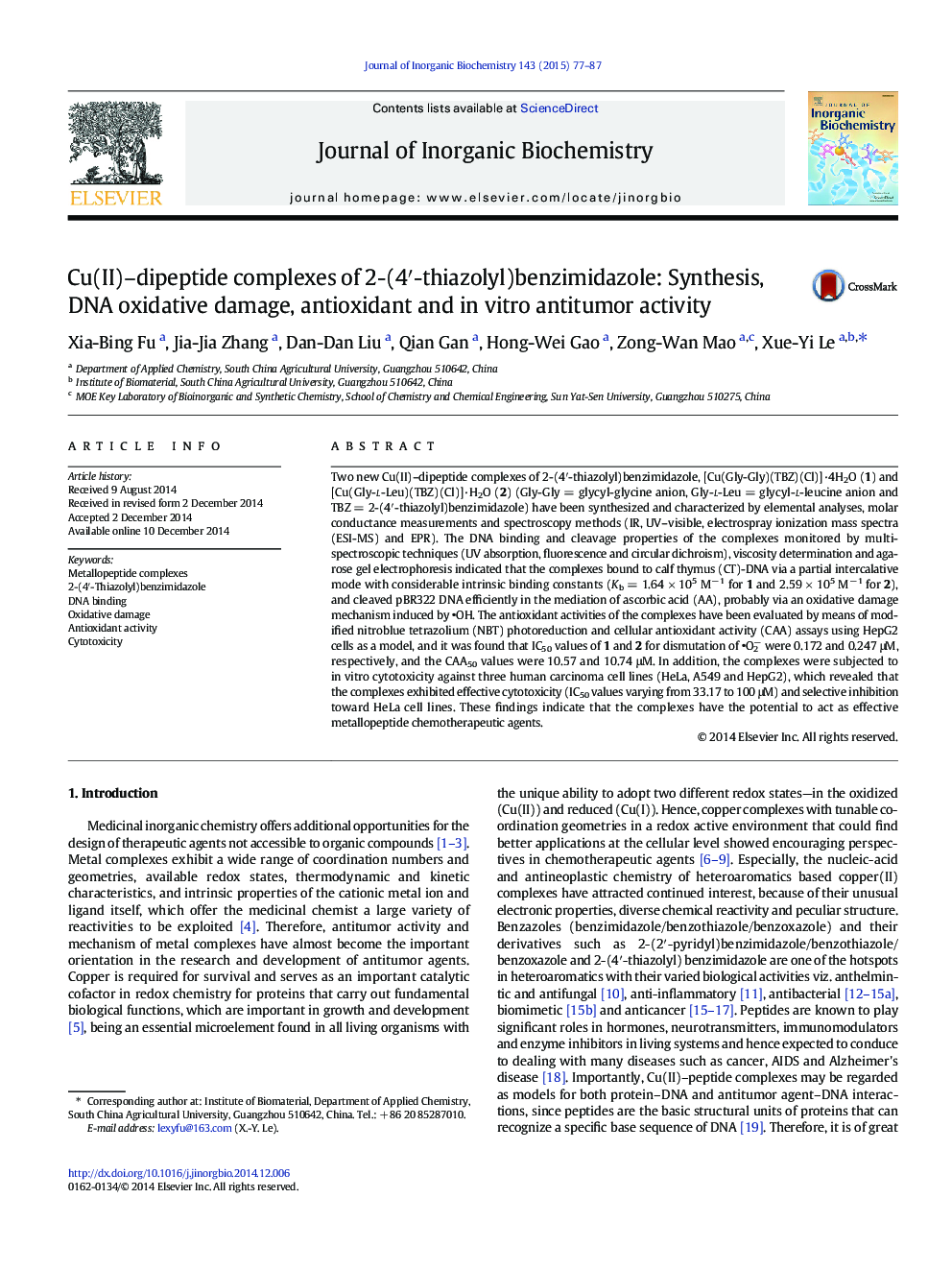| کد مقاله | کد نشریه | سال انتشار | مقاله انگلیسی | نسخه تمام متن |
|---|---|---|---|---|
| 1316565 | 1499444 | 2015 | 11 صفحه PDF | دانلود رایگان |

• Two new Cu(II)–dipeptide complexes with chemotherapeutic potential were prepared.
• The complexes exhibited good DNA binding and oxidative damage properties.
• Prominent ROS scavenging capability for the complexes was confirmed.
• The complexes exert selective and effective cytotoxicity toward HeLa cell lines.
Two new Cu(II)–dipeptide complexes of 2-(4′-thiazolyl)benzimidazole, [Cu(Gly-Gly)(TBZ)(Cl)]·4H2O (1) and [Cu(Gly-l-Leu)(TBZ)(Cl)]·H2O (2) (Gly-Gly = glycyl-glycine anion, Gly-l-Leu = glycyl-l-leucine anion and TBZ = 2-(4′-thiazolyl)benzimidazole) have been synthesized and characterized by elemental analyses, molar conductance measurements and spectroscopy methods (IR, UV–visible, electrospray ionization mass spectra (ESI-MS) and EPR). The DNA binding and cleavage properties of the complexes monitored by multi-spectroscopic techniques (UV absorption, fluorescence and circular dichroism), viscosity determination and agarose gel electrophoresis indicated that the complexes bound to calf thymus (CT)-DNA via a partial intercalative mode with considerable intrinsic binding constants (Kb = 1.64 × 105 M− 1 for 1 and 2.59 × 105 M− 1 for 2), and cleaved pBR322 DNA efficiently in the mediation of ascorbic acid (AA), probably via an oxidative damage mechanism induced by OH. The antioxidant activities of the complexes have been evaluated by means of modified nitroblue tetrazolium (NBT) photoreduction and cellular antioxidant activity (CAA) assays using HepG2 cells as a model, and it was found that IC50 values of 1 and 2 for dismutation of O2− were 0.172 and 0.247 μM, respectively, and the CAA50 values were 10.57 and 10.74 μM. In addition, the complexes were subjected to in vitro cytotoxicity against three human carcinoma cell lines (HeLa, A549 and HepG2), which revealed that the complexes exhibited effective cytotoxicity (IC50 values varying from 33.17 to 100 μM) and selective inhibition toward HeLa cell lines. These findings indicate that the complexes have the potential to act as effective metallopeptide chemotherapeutic agents.
Good DNA oxidative damage, prominent ROS scavenging capability, and selective and effective cytotoxicity in vitro against HeLa cell lines were confirmed for two new Cu(II)–dipeptide complexes of 2-(4′-thiazolyl)benzimidazole.Figure optionsDownload as PowerPoint slide
Journal: Journal of Inorganic Biochemistry - Volume 143, February 2015, Pages 77–87